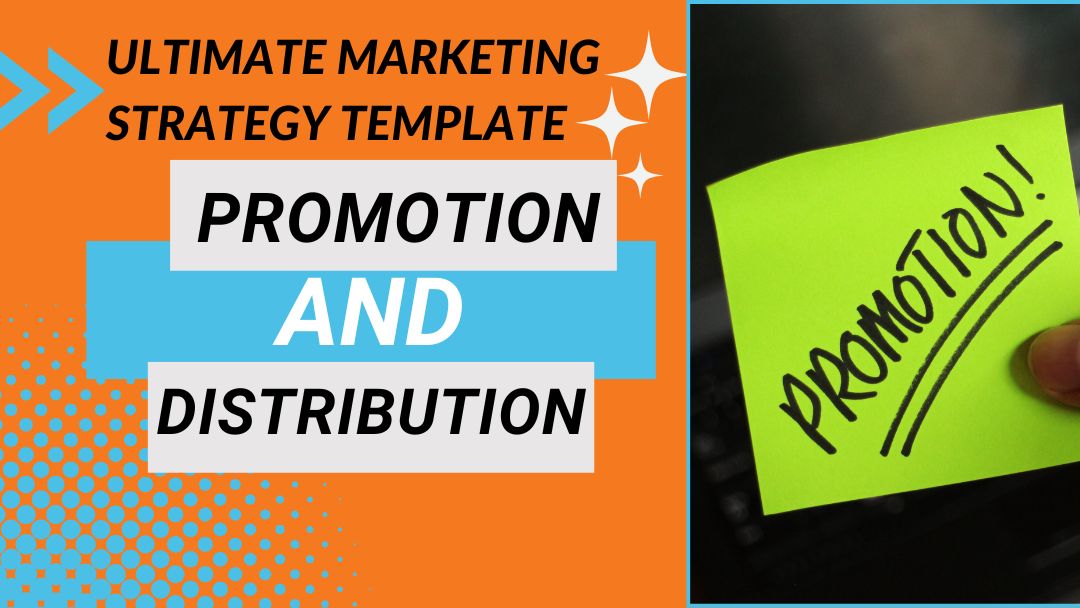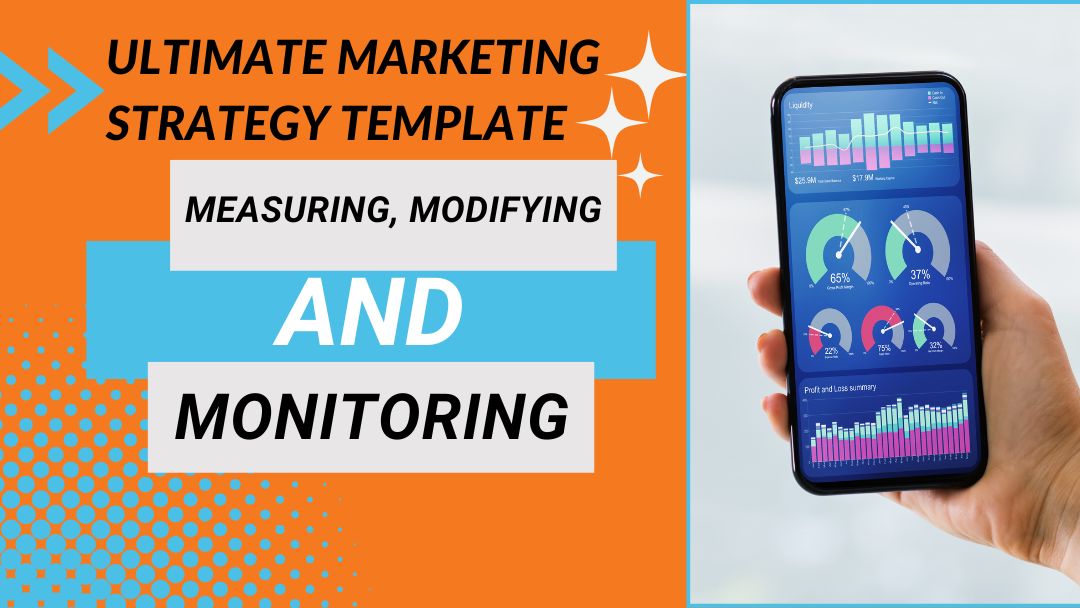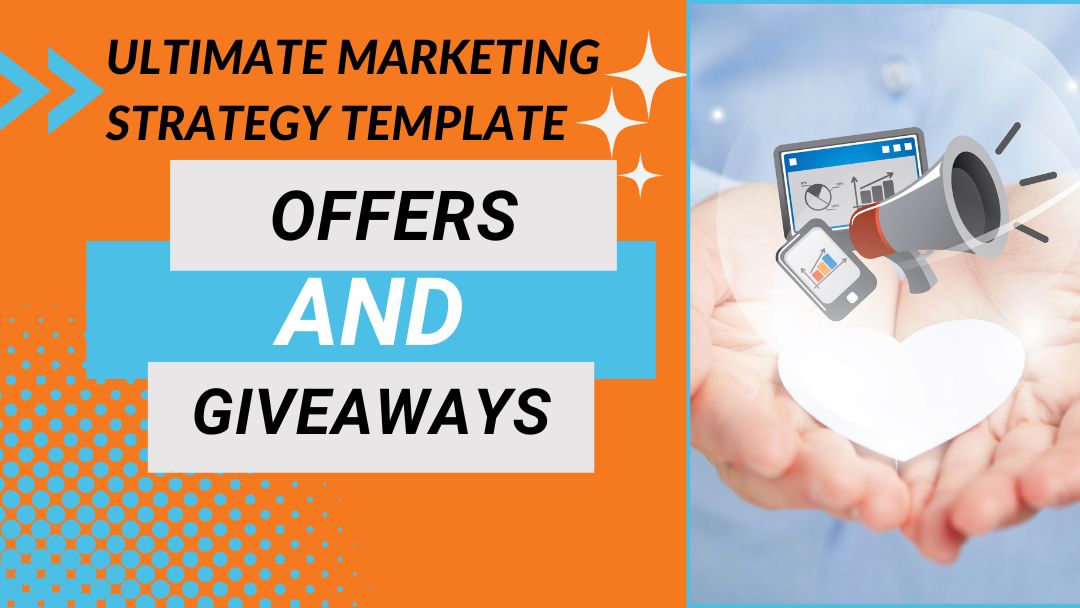Your marketing strategy is one of the most valuable business documents you’ll produce for your business. A solid strategy gives you a map of where you want to take your business and how you are going to reach each goal along the way.
Through careful research, you’ll produce a clear route for each and every step of your marketing strategy, activities and tracking.
Not only will your strategy give you much more confidence in your business and in your ability to take it forward, but it will also give other people – such as investors – a clear way to evaluate the viability of your business.
As part of our ultimate marketing strategy, we’ve delved into how to create your Executive Summary, Market Research, Target Market, Competitor Research, your Unique Selling Points (USPs), and last week, Positioning and Pricing. In this week’s Part 7, we’re exploring the marketing promotion and distribution part of your marketing strategy.
What Is the Marketing Promotion and Distribution part of your Strategy?
Your promotion and distribution section outlines the processes you will use to deliver your products and/or services to your customers.
Here, you need to think about the different marketing delivery channels that are available and relevant, considering how well they fit with your target audience. You must also include details about any wholesalers and suppliers you use as this will help you put contingencies in place if there are disruptions in the delivery chain.
A promotion strategy is defined by the plan and tactics you implement in your marketing plan, in order to increase the demand for your product or service. Promotion strategies play a vital role in the mix of marketing (product, price, placement and promotion), and they revolve around:
- Target audience – who you selling to and what are their interests
- Budget – how much you are able/happy to invest
- Plan of action – the strategy you are adopting to reach your purpose and make a profitable business
Your marketing promotion and distribution strategy is an actionable plan to tell people about your business, to create awesome content and engage in captivating marketing activities to draw people to your brand.
With so many messages, options and voices, this part of the marketing strategy visualises how you’ll perform your marketing strategy, communication and content activities, while having your market research results, target market findings and competitor knowledge at the forefront on these activities.
Create emotional connections, spark interest and captivate your consumers to build your brand as one that can’t simply be ignored.
What are the Benefits of Marketing Promotion and Distribution?
Reaching out to consumers with products and services via well-planned and dedicated marketing activities means you can connect with them authentically and consistently. You can increase the likelihood of converting these into customers, loyal fans and brand advocates.
Here are some of the main benefits of promoting and distributing your marketing strategy:
- Target your intended audiences
- Build awareness of your brand by alerting these target audiences to your presence in the marketplace. Formulate your marketing messages, based on your USPs and your distribution/outreach strategies.
- Generate demand and drive traffic. Create captivating and compelling content that converts. Let consumers know why your products and services are so great by emphasising their features, but more importantly, the benefits of your product and services.
- Encourage call-to-actions to encourage consumers to actively and easily engage with you. These should appear on your website, digital advertising, blogs, PR and social media to spearhead conversions.
- Increase your number of qualified leads
- Stand out from your competitors and stay ahead of your competitor market by gaining an edge
- Offer more value to your consumers, customers and create extraordinary customer relationships
- Find potential collaborators and partnerships to strengthen and broaden your offering
- Grow your sales and profits
Why Is Marketing Promotion and Distribution Important?
Without this section, you’ve simply got an awesome document with any direction or traction. It’s like an artist having an amazing collection of ideas, without any outlet to express them. You can have a comprehensive and exciting marketing strategy on paper but that’s where it stays.
It’s about connecting with people in the right places at the right time while managing your brand’s reputation.
These are the three most important elements to consider when producing the marketing promotion and distribution part of your strategy:
Physical Distribution
Your first step is to outline your product’s manufacturing processes or service’s creation steps.
Consider:
- How will you reach your customers (new and existing)?
- How will you manage your brand’s reputation?
For your products, answer these questions:
- Where will you buy your parts?
- Who will make/assemble the product?
- Where will production take place? Location is important in physical distribution. Your product needs to reach your customers by set deadlines and in a cost-effective way.
- Where will you store your product (e.g. warehousing)?
For your services, answer these questions:
- Who will produce your service/s?
- How will you find these suppliers?
- What timeframes will you work to?
- Are there specific technologies involved?
For each answer, make sure you clearly outline the costs involved. The next step in your physical distribution plan is to consider the type of services you will use to deliver the products or services to your customer. For example, if you have physical products, you might want to use a courier or Royal Mail.
When choosing your supplier/s, you must consider the needs of your customers as a priority. Can these organisations get your product or service to your customer on time and in a delivery model that matches their expectations?
Marketing Channels
Your marketing channels are how you communicate with consumers and customers. It’s how you tell them about your product or service, including associated marketing, such as offers and promotions.
The trick to choosing the best marketing channel is to understand your customer fully by researching your market, target audiences and competitors too. It’s important when developing your campaign to use multiple channels to communicate your message and be where your consumers and customers are.
You also need to decide if this is something that you want to keep in-house or pair up with a reliable communication and content company to partner with. Collaborating with knowledgeable and experienced marketing professionals doesn’t have to break the bank. Hone your brief and choose your specific marketing products or services to manage your budget.
Your best marketing channels are those that give you the greatest exposure to the people who will buy your products or services. By doing plenty of research on your target audience, you’ll have a solid foundation as to which channels to start using.
Brainstorm the marketing and promotion strategies that are available to you and your business. These may include:
- Website
- Content marketing – Write articles, give advice, become known as an expert
- Online advertising
- Networking – go where your market is
- Direct marketing – sales letters, brochures, flyer
- Advertising – print media, directories
- Training programmes
- Direct/personal selling
- Press relations
- Trade shows
- Product Availability
Your products or services need to be available to your customers in a reasonable timeframe, with minimal disruptions to your supply chain. You need to know exactly how long it takes to produce, store and deliver your products or services.
You also need to keep an eye on manufacturing and delivery supply chains. You need to put contingency plans, such as a list of alternative reliable and trusted suppliers in place, should part of your chain fail.
Let’s Hone in On Your Marketing Channels
In the marketing channels, activities and materials section of your marketing strategy, you need to consider what materials you can use to make your potential customers aware of your products/services.
Marketing materials are the promotional items you use to get your brand out there. They include:
- Websites and copywriting
- Blogs
- Case studies
- Press releases
- Technical articles
- Frequently Asked Questions (FAQs)
- Social media content
- Videos
- Podcasts
- Brochures
- Leaflets
- Posters
- Business Cards
- Letterhead
- Compliment Slips
- Catalogues
- Newsletters
Every business benefits from using marketing materials. There may be some businesses out there that don’t use them, but I’ve never heard of them…and that’s probably why!
Put the Foundations in Place for Your Marketing Strategies
Getting your marketing strategy right means implementing solid and consistent practices from the very beginning. Your foundations must be strong if you want to build a brand with an online presence:
Choose Your Platforms
Build your online presence by selecting platforms to be present and visible on. Examples include websites, blogging platforms and social media platforms.
When choosing your platform, think about your target audience and where they hang out online.
For example, if your product is very visual (you may sell art or fashion for example), then it makes sense to have an account on engaging image-based visual platforms like Pinterest and Instagram. If you create tabletop games, a YouTube channel showing people playing those games is a good choice.
Here, you need to research the different options out there and decide if they’re compatible with your brand, products/services and audience/s.
Search Engine Optimisation
Search engine optimisation (SEO) is a set of techniques and strategies that increase the number of visitors (known as “traffic” in digital marketing lingo) to the site by obtaining a high rank in the search results of a search engine (e.g., Google, Yahoo, Bing).
You’ll spend time researching keywords, writing meta descriptions, along with a whole host of other activities to find those that are most relevant to your products and services. Click here for a comprehensive guide on SEO.
Create Captivating Copy
The words you use will help you sell your products and services. Content is king, or queen, after all, so here are a few tips to help you:
– Solve a problem
We’re drawn to products and services that provide a solution. This problem could be anything from boredom (e.g., solved by playing your games) to poor quality sleep (e.g., solved by a comfy bed). You must frame all your copy in such a way that it offers your customers a solution to their problem. EVERY, SINGLE, TIME. Remember: “People buy a good night’s sleep. They don’t buy a bed”.
– Use Language your Customer uses
Knowing your target audience means you have a better handle on the style, tone and voice to use to engage with your consumers and customers. Check out our blogs on tone of voice for some real-world examples of how to do this.
– Keep It Simple
People don’t like to read walls of text online. They want to see the information they’re looking for as quickly as possible. Keep sentences short and avoid unnecessary words.
A good guide to help you get your writing on point is Strunk and White, The Elements of Style. This will help you with the flow of words, but for help with the actual content and message, you need to learn from the copywriting greats. Two of the best known are Joseph Sugarman and David Ogilvy.
How to Get the Most Out of Your Marketing Materials
When done well, your promotional products will expose your brand to the greatest number of people — your target market. They will stand out and share interesting information, relevant to the reader.
- Design: Your marketing materials will sport your branding including your logo, company colours and imagery, making it easy for people to spot and identify you straightaway. Aligning the visual representation of your brand with its underlying personality by using designers, photographers and printers will reduce the risk of rebranding.
- Your Brand Style, Tone and Voice. How you communicate with your consumers and customers needs to reflect your brand and convey the right messages and your USPs to your customers. Marrying your key messages with your content style, tone and voice will communicate your brand and stay memorable and relevant.
- Consistency. Reaching your prospective and existing customers is one thing. Keeping them interested and engaged in what your brand is offering is another. Regular, frequent and consistent content, messaging and outreach is key.
Get Your Marketing Strategy Promotion and Distribution Right
There are plenty of techniques and methods that you can employ in your marketing strategy. Let’s look at some of the popular choices and the reasons why people use them.
– Video Marketing
With the huge improvements in video technology and its availability to anyone with a half-decent smartphone, it’s no surprise that video is a popular choice for content creators.
Why is it such a good choice? Here are two stats that every business owner should care about:
- People are more likely to watch a short video (note the word short!) than read an equivalent text.
- People are more likely to remember a call to action after watching a video than reading text.
You can create a single video at a time and upload it across your online networks, such as your website and social media channels. You could even post to affiliated websites if you develop good relationships with businesses in a relevant niche.
– Email Marketing
Email marketing is a good choice. There are a few rules to keep in mind:
- Never send emails without consent
- Don’t send too many emails because people will unsubscribe
- Keep emails relevant to the person. This might mean having separate email lists for customer types and separate offers.
- Site pop-ups are a good way to get people to subscribe to your list, but you must be careful that the pop-up is offering them something worthwhile (e.g. a free sample, a free download) or they will bounce. Make the pop-up as unobtrusive as possible by ensuring that it doesn’t obscure what the person is already reading.
– Blogs
Regular blogs to your website are a great way to keep people engaged in the site and to optimise for more keywords (see the link under Search Engine Optimisation (SEO) above). You can also post them across your network and repurpose them to create new content.
– Social Media Promotion
Hang out where your consumers are, engage in two-way conversations, chat with consumers and convey exclusive offers and discounts to your existing customers on social media platforms including LinkedIn, Twitter, Instagram, YouTube, Pinterest, Facebook and Google+.
The epitome of direct marketing, social media, builds a personal connection and removes barriers between the brand and potential buyers, providing human customer service and decision-making experience.
Use social media advertising, contests and promotional giveaways to draw in users to your profiles. Opt for eye-catching visuals, create a content hook to encourage shares, produce a consistent content strategy, optimise your content for mobile, share your content at the optimal time for your target audience and add clear call-to-actions.
Don’t forget to mention your sources and the influencers that are related to your content when you share! They’re likely to reshare your post.
– Public relations
Build your reputation, develop a thought-leadership position and reach wider audiences by developing your presence with local, national and international press, depending on your business outreach goals and target audience/s.
Generate leads in a cost-effective and highly targeted way by shaping a strong brand image, creating positive media coverage, establishing yourselves in your marketplace, maximise your brand’s reputation and attract investors, stakeholders, partners and employees.
– Customer Reviews & Testimonials
One thing that many marketers overlook is third-party review sites (and some overlook reviews on their sites and platforms!). Review sections are a great place to engage with consumers because you can showcase your customer service skills. Read our great customer service info to understand why it’s so important.
– Customer Feedback and Loyalty Programmes
How you look after customers post-sales is as important as pre-sales to encourage returning customers and customer retention. Maximise customer satisfaction and their overall experience by understanding the service they have received, how happy they are with the products/services and answer any questions or queries they may have.
You’ll gather honest feedback about how customers feel so you can hone and improve your processes and systems for future marketing and sales.
A customer loyalty programme such as reward and referral programmes also encourages customers to come back to you and make frequent purchases, enabling you to increase profits over the long-term.
Outsourcing Your Distribution Strategy
Many businesses choose to outsource their business’s distribution as they make your projects easier to manage.
While it’s natural to worry about having less control over your products/services’ distribution, the flip to this downside is that given these third party businesses are specialists in distribution, they have the skills and experience to manage distribution projects effectively.
It can give you time back to focus on other things, the assurance that they have the skills to complete the distribution to a high standard and peace of mind that your marketing activities are taking shape and are consistent.
When choosing a partner to support and manage distribution, you can research and ask the following questions:
- Do they specialise in distribution?
- How do their existing customers rate them?
- Do they have experience distributing to your target audience?
- What backup support do they have in place for disruptions?
- What are their delivery times?
- Are they competitive?
- Will they manage customer services?
Managing customer services is particularly important because they have access to information that can explain what happened if part of the delivery process goes wrong. Alternatively, you’ll need to provide the customer services yourself and liaise between the distributor and the customer. This option can add a level of confusion that can frustrate customers and encourage them to shop elsewhere.
Summary
Promoting and distributing your brand, products and services involves a strategic, directional and comprehensive plan that is based on your Market Research, Target Market, Competitor Research, your Unique Selling Points (USPs) and Positioning and Pricing.
With this complete, you’re ready to reach your target consumers in an on-brand, successful and well-thought-out way that maximise relationships, sales and profits. Use it to select your marketing channels, activities and to craft your captivating and compelling content.
What Next?
Make Your Mark. Find Your Roar!
Check out the rest of our Ultimate Marketing Strategy series for guidance, insights and tips:
- Part 1: Executive Summary
- Part 2: Market Research
- Part 3: Target Market
- Part 4: Competitor Research
- Part 5: Unique Selling Points (USPs)
- Part 6: Positioning and Pricing
- Part 7: Marketing Promotion and Distribution
- Part 8: Budget: Offers and Giveaways
- Part 9: Marketing Goals and Conversions
- Part 10: Marketing Metrics: Measuring, Modifying and Monitoring





0 Comments